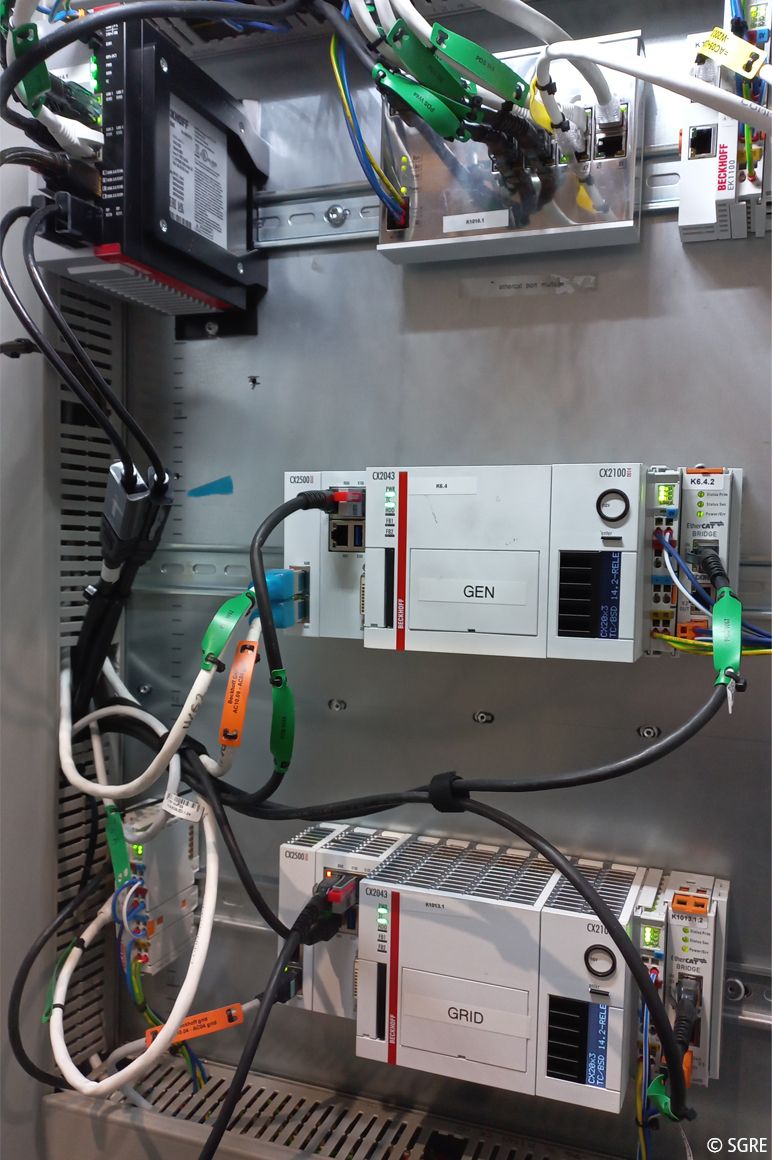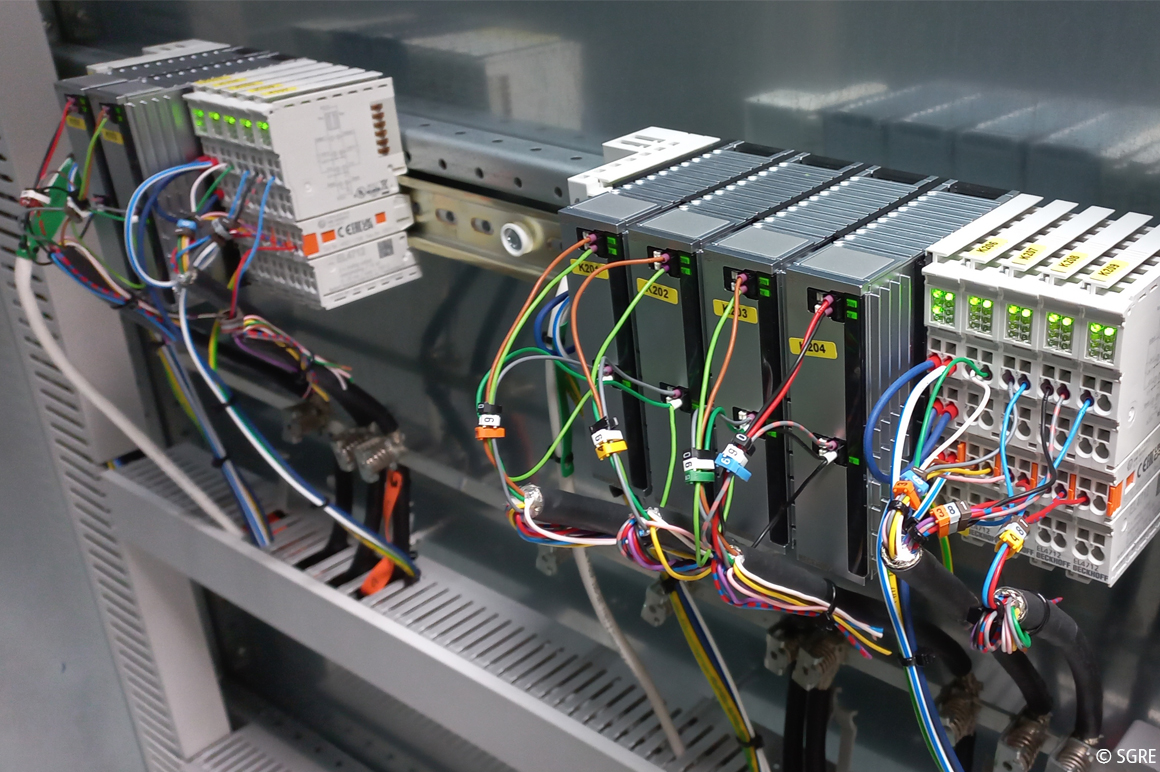Automated converter testing for next-generation wind turbines
As the prevalence of renewable power generation increases, Europe’s electricity grid is undergoing a fundamental transformation – particularly due to the increasing use of converter systems that are coupled to the grid via power electronics. This results in new requirements for modern test rigs, which Siemens Gamesa Renewable Energy A/S (SGRE) has implemented with the Grid-Converter Test Rig (G-CTR) using PC- and EtherCAT-based Beckhoff control technology.
Modern power electronics enable extensive controllability for grid support. Compared to conventional synchronous generators, however, they are less able to provide short-circuit current, which limits the support for the grid in the event of a fault. With regard to system stability, controlling the interactions between generation units in terms of subsynchronous and harmonic stability at system level is also becoming increasingly important.

Against this backdrop, wind turbine manufacturers are conducting test campaigns on prototypes to determine grid characteristics and create validated models of electrical behavior that are required for further analysis at system level. Conventional testing and validation procedures for wind turbines are technically mature and have been successfully applied in field operation for many years. However, the growing challenges of modern power grids require complementary approaches to extend the scope of validation beyond traditional methods. For this reason, Siemens Gamesa employs innovative methods for validation on modern test rigs in addition to the existing field tests. Programmable grid emulator systems are used in combination with many years of field experience to expand the scope of validation in a targeted and efficient manner.
Modern test rigs extend the scope of validation
The Grid-Converter Test Rig is a test rig for flexible and reproducible testing of the wind turbine converter system, a key component that has a significant influence on grid properties. Testing and validation in the field is carried out under real conditions on the entire generation unit. However, since the grid conditions there can only be changed to a limited extent, a programmable grid emulator on the test rig offers extended validation potential – both for static and transient grid characteristics and for harmonic behavior. Due to the adjustable supply voltage on the test rig, flexible operation is possible across the entire operating range in terms of voltage, active power, and reactive power. This makes it possible to validate the grid-serving performance of the wind turbine converter system on the basis of measurements, which is not possible in this form under field conditions. In addition, the adjustability of the grid short-circuit power as well as of the X/R ratio enables the realistic simulation of field-specific grid scenarios for offshore wind farms – both in normal operation and in the event of a fault. The targeted injection of voltage harmonics also makes it possible to determine the frequency-dependent impedance behavior, which forms the basis for validating harmonic models of the entire electrical system.
The G-CTR Power Hardware-in-the-Loop (PHiL) test rig was built by SGRE in Brande, Denmark. Siemens Gamesa relies on PC-based control and support from Beckhoff to meet the high requirements regarding automation, fast and dynamic control, and the acquisition and recording of high-frequency signals, voltages, and currents.
In the G-CTR, the converter being tested – the device under test (DUT) – is positioned between two grid emulators. These ABB ACS6080 medium-voltage converters offer advantages for PHiL due to their precise emulation of grid conditions and high flexibility. The converters are used to carry out realistic tests and certifications of energy sources such as wind turbines by simulating various grid scenarios and fault conditions. One medium-voltage converter emulates the grid on one side and the other converter emulates the generator on the other. The grid emulators can set three-phase voltages and currents highly dynamically, generate grid faults, and emulate impedances and harmonics.
These grid emulators are connected via EtherCAT to the higher-level test controller, which defines the test scenarios and monitors the system, including other subsystems such as the cooling and safety system. This involves using a C6030 ultra-compact Industrial PC from Beckhoff, which combines the numerous EtherCAT networks via a CU2508 real-time Ethernet port multiplier.
Two Beckhoff CX2043 Embedded PCs also enable highly dynamic control of the grid and generator emulators via the EL6695 EtherCAT bridge terminal and integrate simulation models for HiL test procedures, among other things. These PCs receive the specifications from the test scenarios from the test controller and execute modules developed in MATLAB® and Simulink® that were transferred to TwinCAT via TwinCAT 3 Target for Simulink® (TE1400). These simulation models simulate the raw values of the exact voltages and currents, including the phase positions and any other desired effects. The voltages and currents of the converter are measured via EtherCAT I/O modules and integrated into the simulation models for control and correction. The EL3783 grid monitoring terminal is used to measure 690 V directly on the grid side and the ELM3002-0205 high-voltage measurement terminal is used to measure up to 1,200 V on the generator side.
The entire wind turbine is mapped by Siemens Gamesa in real time using a simulation (BHawC) and communicates with the turbine controller, which in turn communicates with and controls the converter controller. The SGRE proprietary interface for controlling the systems was implemented via a TwinCAT C++ module and with TwinCAT 3 TCP/UDP Realtime (TF6311) and integrated in the test controller.

Automated test management, comprehensive visualization
The test controller enables fully automated execution of the large number of test scenarios by integrating test profiles. These profiles define the states that must be fulfilled as preconditions for the test, the states and signals to be passed through during the test as time sequences, and the states that are to be fulfilled again afterward (post-conditions). Hundreds of profiles are defined, selected in the visualization, and then automatically processed one after the other. All the operator has to do is observe the test sequences in the visualization and intervene if necessary in the event of an error. This not only simplifies the execution of the test scenarios, but also speeds them up and makes them reproducible. Reproducibility without manual intervention is particularly relevant in order to be able to map scenarios from the field or submit them for certification.
The entire visualization was implemented with TwinCAT 3 HMI (TF2000). It enables the system to be started and stopped easily, test profiles to be managed and executed, and all states and signals from the various subsystems, emulators, and the converter to be diagnosed and visualized. In addition, TwinCAT 3 Scope View (TE1300) is used intensively to record and display individual signal curves from the high-resolution raw data in charts as required. For independent measurement via a redundant measurement system, this data is made available to external tools via TwinCAT 3 OPC UA (TF6100). This enables automatic triggering to start and stop recordings of the external measurement system as well as automatic execution and recording of the tests.
CPU optimizations and EtherCAT for fast sampling
The ACS6080 converter can be controlled, parameterized, and supplied with setpoints as magnitude and phase position via an EtherCAT interface. The power electronics can also be given the instantaneous values for the voltages with a sample time of up to 25 µs via ABB’s own communication interface. To utilize this interface, Siemens Gamesa became a member of the EtherCAT Technology Group (ETG) and has developed its own communication interface as an EtherCAT slave based on an FPGA and the EtherCAT IP core.
CPU optimizations are used to ensure that the instantaneous values for the voltages can be provided as quickly as possible by the simulation models. The CX2043 Embedded PC with AMD Ryzen™ processor is suitable for such highly deterministic applications – due to the powerful multi-core architecture and the use of specialized CPU instruction sets that enable precise and fast data processing. For this purpose, the processor provides instruction sets such as AVX2 to speed up parallel calculations by means of vectorization. The Embedded Coder® from MathWorks® optimizes C/C++ code specifically for high-performance real-time systems by adapting it to the target hardware and using these special instruction sets. This results in higher efficiency and lower storage requirements. With TwinCAT 3 Target for the Embedded Coder® (TE1402), this optimized code can be transferred to TwinCAT modules and executed in real time.
Advantages of automation
From SGRE’s point of view, the advantages of this automation solution are manifold: The use of EtherCAT and PC-based control technology from Beckhoff creates a high-performance and flexible test environment that can precisely map even highly complex and dynamic scenarios. The integration of MATLAB® and Simulink® models in TwinCAT enables seamless implementation of control and simulation requirements, while the comprehensive diagnostic and visualization options provided by TwinCAT 3 HMI and TwinCAT 3 Scope View ensure detailed monitoring and analysis of the test processes.
In summary, the innovative test environment from Siemens Gamesa – supported by automation technologies from Beckhoff – offers an efficient, reliable, and reproducible solution for testing and validating multi-megawatt converters for wind turbines. This not only helps to speed up the market launch of new products, but also ensures that they meet the stringent requirements of grid operators and regulatory authorities.